About Manetism Easy Science Fro Kids About Magnetism Easy Science for Kids
In this experiment, you can make kids learn about the items that get attracted to magnets. It is the best physics experiment for small kids.
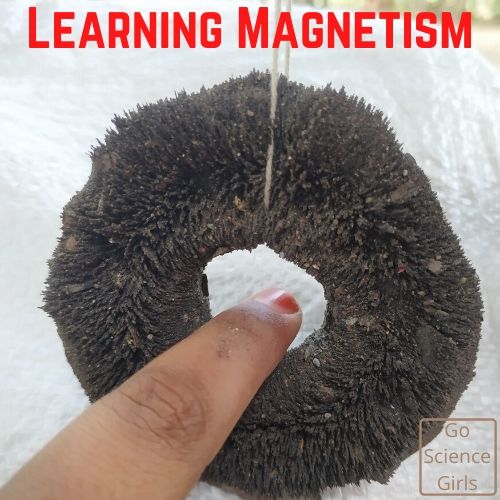
Magnets are amazing things for kids to create interest in science. You can do wonders with magnets. They also play a very critical role in wide areas of practical scientific applications.
On last Sunday, we were discussing about possible other experiments to do at home. At first, the magnet experiment caught Prithika's attention. She wanted to do it and I thought I can teach her about magnetism and magnetic force. This is nothing but just using a magnet to check which items at home gets attracted to it.
Suitable For
Kids from age 3 to 9 can try this. Different aged kids will infer different information per their age. Therefore try this with preschool, kindergarten, and primary school kids. I did this with my elder daughter 8 years old and younger one 6 years.
Things required
- Magnet – We used a big ring magnet and a stick magnet. You can use the same size or a bigger one.
- Items for testing magnetism. These included metals, plastic, wood, chalk, vessels, nails, keys, etc.
- Paper/Notebook
- Water & Oil
- Glass Jar
- Bowls
Magnetic Experiments
1. Classification of Materials

We spread across the following items in a mat and asked my daughter to start testing them for attraction with a magnet.
- Keys
- Plastic playing coins
- Screws
- Few Pennies
- Safety Pins
- Paper Pins
- Mouse Ball (yeah the old one)
- Blue stones
- Seeds
- Few more items that we could find from scraps.
Then she started the experiment. She checked with the magnet and segregated things that were attracted by the magnet in one side and not attracted in another side.

Oh, I missed it. She actually first wrote the list of items which she thought will get attracted and the others. Then tested whether her understanding is correct.
After sorting the items upon checking with the magnet she checked her list and understood that metals get attracted to a magnet. However, wood, plastic, and chalk do not.
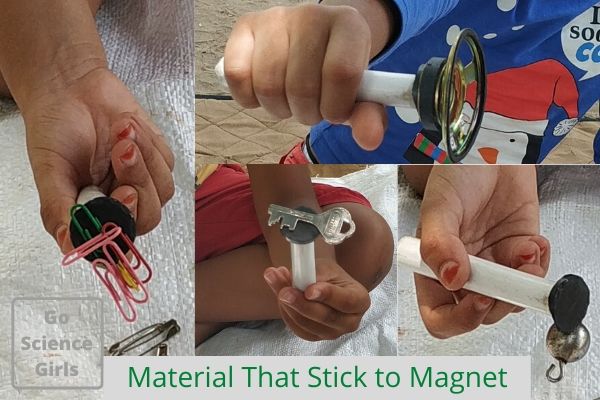
She listed key, fork in the attracted to list. But in reality, it was not so, they landed in the not attracted to list. When she curiously asked me I explained to her that metals that contain iron will get attracted and not others. I told her about silver and gold metals and they do not get attracted to a magnet.
She also played by keeping the magnet above the "attracted place" and felt glad that all items stuck to the magnet. I now explained to her about magnetism. The items got attracted are not magnetic items but they got attracted due to their property that was pulled by the magnetic force.
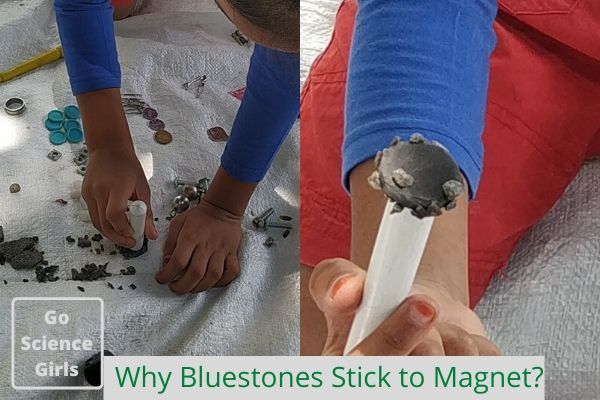
We were amazed to see Blue stone gravels stuck to magnet and we learned that some of the stones have ingrained materials that are attracted to magnets.
Now, it's time to learn spellings. She verified with me about the names of the items which she did not know and spelled them phonetically. Best way to learn the spelling of many new words. I was glad.

She listed key, fork in the attracted to list. But in reality, it was not so, they landed in the not attracted to list. When she curiously asked me I explained to her that metals that contain iron will get attracted and not others. I told her about silver and gold metals and they do not get attracted to a magnet.
2. Measuring Strength of Magnet
It was time for us to take the next step in the experiment. After classifying the things, I wanted my daughter to learn about the strength of the magnet.
Not all magnets have equal magnetic strength. It varies based on the size, shape and of course on the materials in which the magnet is made.
How can we simply showcase strength of the magnet? We took a simple approach. I asked my daughter to keep attaching coins to the magnet but not directly. Each of the next coin would be attached to the previous coin and we tested how much can the magnet hold.
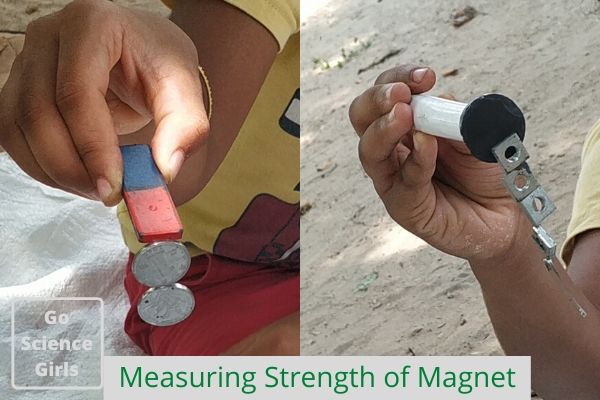
Our Bar magnet was able to hold 2 to 3 coins while our ring magnet could hold more than 4. We even tested with couple of screws and bolts.
We didn't have a Gauss Meter to measure the strength but this experiment was good enough to prove that each magnet has difference in their magnetic strength.
3. Separating Iron Fillings from Sand
Prithika was impressed after seeing the blustones sticking to the magnet and asked us how does a stone stick to a magnet?
I thought it would be fun to make her understand by separating iron filings from sand. Though I wasn't sure how much iron fillings I would be able to separate, we thought it is worth to test it.
I gave my daughter a big ring magnet and asked her to play with in the sand and observe. She did all possible things with magnet and sand. Initially she dragged the magnet across the sand and started pouring sand on top of the magnet. Finally, when she was done with her play. I showed her the small particles that was stuck to the magnet.
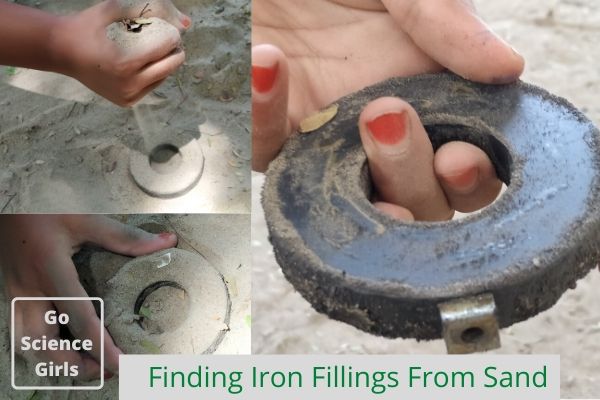
We finally found enough iron fillings from the sand. I asked Prithika to carefully separate them out and store them in a bowl.
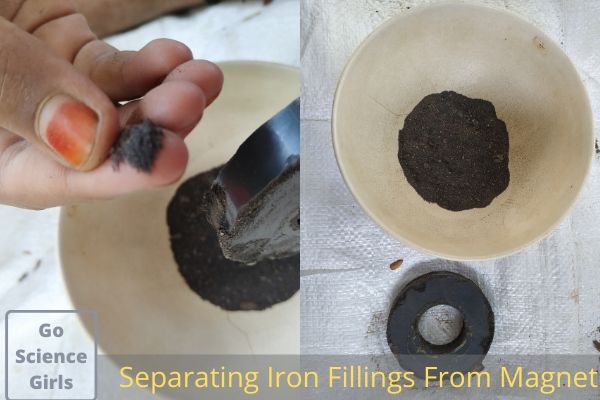
It took her about 10 minutes to save the iron fillings in the bowl. Now I showed her that even sand has iron fillings. Similarly some of the rocks have high iron or metal content which can work as magnetic material and gets attracted by magnet.
I am sure , she understood the lesson through this fun activity.
To make things even more fun, we poured the separated iron fillings into a plastic box and I started circling the magnet underneath the box. The particles started dancing in line with the magnet' movement. Both my daughters were jumped on joy seeing this. I let them play for a while before starting our next experiment.
4. Magnetic Property Under Liquids
Tisha asked me on whether she can play with magnet in water? That's when I thought why don't we teach how magnets work under liquids.
I took a plastic container and filled water. I asked Prithika to pour the iron fillings in the water. Now I asked her to use the magnet to move the iron fillings across the container. She was happy to see the iron fillings stuck to the surface of the container where the magnet was placed. She tried to drag the magnet across the container and saw the iron fillings followed her.
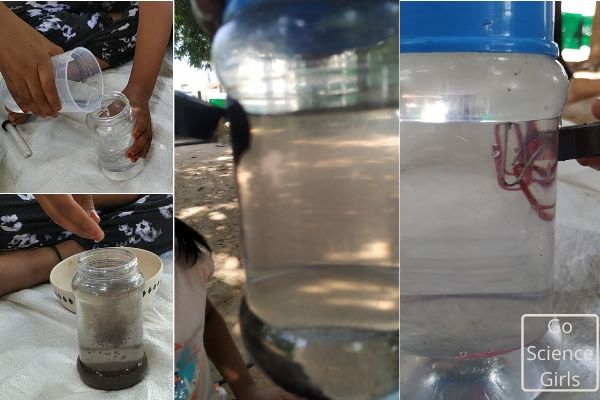
Similarly, we tried this with paper clips in the water. They also followed the magnets.
This helped my kids to understand magnets do work under water.
Science Behind Magnets
The magnet produces a magnetic field and that will attract things that contain magnetic property. For instance, iron or any metal that contains iron is pulled by the magnetic force. Fridge magnets are the classic example which gets stuck to the refrigerator door as they are made of steel. Two magnets will get either attracted or repelled based on the poles. Like poles repel and unlike poles attract each other.
Check for more physics activities on physics activities for kids.
Few best ones for your reference
- Playing around with Refraction of Light – STEAM activity
- Easy Catapult
- 3D challenge
- DIY Balance Scale
- Heart-shaped bubble wands
Word of Caution
Make use of big magnets so that there is no choking hazard of children swallowing it. Apart from that, even magnet can get attracted inside the gut leading to severe health problems. Ensure kids safety and then provide them with magnets. Also, closely monitor them to avoid any accidents.
Disclaimer : This post contains affiliate links from Amazon. An affiliate link means that when you purchase using the link provided in this page, I would get a small referral fees WITHOUT any extra cost to you. I highly appreciate your understanding and support.
Source: https://gosciencegirls.com/magnet-science-experiment-kids/
0 Response to "About Manetism Easy Science Fro Kids About Magnetism Easy Science for Kids"
Post a Comment